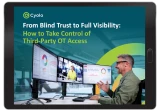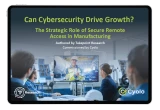Table of Contents
- What is Secure Remote Access (SRA)?
- Why Legacy SRA Falls Short in OT Environments
- 1. Legacy SRA Provides Insufficient Security
- 2. Legacy SRA Requires a Cloud Connection
- 3. Legacy SRA Provides Risky All-or-Nothing Network Access
- 4. Legacy SRA Offers Limited Visibility and Supervisory Controls
- 5. Legacy SRA Cannot Secure Third-Party Vendor Access
- 6. Legacy SRA Leads to Scalability Challenges/Operational Burden
- 7. Legacy SRA Provides a Poor User Experience
- The Bottom Line on Legacy SRA
What is Secure Remote Access (SRA)?
Secure remote access (SRA) is a technology that enables workers to connect from afar to an organization’s internal systems and assets. Solutions that fall under the SRA category include virtual private networks (VPNs), virtual desktop infrastructure (VDI), jump servers, and others.
Most SRA tools on the market today are legacy solutions that were designed before our current era of widespread remote work. These products may be sufficient to secure a limited number of remote connections, but they prove more problematic when used to support a massive remote workforce or to ensure secure access to mission-critical assets. In addition, as we will see in this blog, many legacy SRA tools are built to secure information technology (IT) settings and do not adequately accommodate the distinctive requirements of operational technology (OT) environments.
Why Legacy SRA Falls Short in OT Environments
1. Legacy SRA Provides Insufficient Security
Numerous cyberattacks have shown that legacy SRA solutions like VPNs can be exploited by threat actors with relative ease. This is hardly ideal in the IT context, but it becomes potentially catastrophic when cyberattackers can gain access and take control of the OT systems that control production lines, electrical grids, water treatment facilities, and more.
2. Legacy SRA Requires a Cloud Connection
Legacy SRA solutions typically require a cloud connection. This leaves them unable to support the on-premises, isolated, and legacy-based systems present in many OT environments.
3. Legacy SRA Provides Risky All-or-Nothing Network Access
The principle of “least privilege” states that users and devices should have access only to the resources they need to do their jobs – and nothing more. Many legacy SRA solutions cannot enforce least privilege access. Anyone who connects via such a solution will have access to the full network and could conceivably take control of vital systems and processes, putting both operations and safety at risk.
4. Legacy SRA Offers Limited Visibility and Supervisory Controls
Securing the initial point of access is important, but industrial organizations need to see what is happening throughout the entire connection. This is especially crucial in cases where privileged users, such as remote workers or third-party vendors, are accessing critical infrastructure or other sensitive systems.
Most SRA tools offer limited (if any) visibility into or control over what users can do once they are connected. These solutions cannot detect or respond to unusual activity, nor can they block behaviors that could heighten risk. There is also no way to monitor sessions in real-time or to grant temporary just-in-time (JIT) access that expires once the desired task is complete.
5. Legacy SRA Cannot Secure Third-Party Vendor Access
Securing third-party vendor access to critical systems is a key requirement for many industrial enterprises. Beyond their more general inability to address OT challenges, most legacy SRA tools do not solve this important use case. This may be because they require the downloading of an agent onto the user’s device or because they simply do not provide the level of security and control needed to ensure safe third-party access.
6. Legacy SRA Leads to Scalability Challenges/Operational Burden
Scaling legacy SRA solutions can fast become a logistical nightmare and financial black hole. In addition, the burden placed on already overworked admins is often heavy. Jump servers, as one example, demand substantial and ongoing management. Other SRA tools are difficult to configure and require complicated onboarding and offboarding processes. This isn’t just inconvenient; it can lead to operational delays or system downtime when one-time technicians or other specialists can’t be quickly credentialed to address an urgent problem.
7. Legacy SRA Provides a Poor User Experience
Legacy SRA tools too often provide a subpar experience for end users. Whether it’s sluggish connections, complicated login processes, or other disruptions to the work routine, poor user experience leads not only to frustration but also to shadow remote access that can expose organizations to added risk.
The Bottom Line on Legacy SRA
Legacy SRA solutions are simply not designed to solve the access challenges facing today’s industrial enterprises. Even when they’re able to be deployed in an OT environment, traditional SRA tools can impede system responsiveness, introduce friction for administrators, and cause operational disruptions. These may be inconveniences in an IT setting, but they are dealbreakers for OT.
Unlike legacy SRA, Cyolo PRO (Privileged Remote Operations) is built to meet the unique needs of OT environments. Read our follow-up blog to learn how Cyolo PRO can help your organization overcome the limitations of legacy SRA.
The Manufacturers’ Guide to Secure Remote Access for OT
8 Tips for Choosing a Future-Proof Solution

Jennifer Tullman-Botzer
Author
Jennifer Tullman-Botzer has over a decade of experience in cybersecurity marketing and is as tired as you are of hackers-in-hoodies stock images. She joined Cyolo in 2021 and currently serves as Head of Content. Prior to Cyolo, Jennifer worked in a variety of marketing roles at IBM Security. She lives in Tel Aviv, Israel.

Subscribe to Our Newsletter







